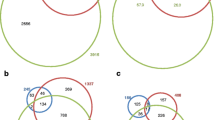Abstract
As an industrial chemical produced worldwide in high volumes, toluene is commonly detected in ambient air and water. It can combine with oxygen and form compounds that are harmful to humans. In recent years, phytoremediation has been increasingly applied to repair the environmental damage caused by pollutants. However, insufficient knowledge is available regarding the response of plants to toluene. To detect the potential genes in plants that are related to the sensing mechanism and metabolism of toluene, a microarray analysis has been conducted on Arabidopsis thaliana seedlings grown on toluene-containing media. Following the validation of data and the application of appropriate selection criteria, the results show a coordinated induction and suppression of 202 and 67 toluene-responsive genes, respectively. Within the functional class “metabolism”, the genes encoding detoxification proteins represent the most strongly up-regulated group. These include genes encoding cytochrome P450s, glucosyl transferases, and transporters. Subsequently, the toluene-induced genes of Arabidopsis are analyzed in detail.





Similar content being viewed by others
References
Potter TL (1992) Fingerprinting petroleum products: unleaded gasolines. In: Kostecki PT, Calabrese EJ (eds) Petroleum contaminated soils, vol 2. Lewis Publishers, Chelsea, pp 83–92
Reisch MS (1992) Top 50 chemicals production stagnated last year. Chem Eng News 70:16–22
Fuller ME, Scowl KM (1996) Effects of toluene on microbially-mediated processes involved in the soil nitrogen cycle. Microbial Ecol 32(2):171–184
Mark EF, Kate MS, Sean L, Howard F (1997) Trichloroethylene (TCE) and toluene effects on the structure and function of the soil community. Soil Biol Biochem 29(1):75–89
Hannink N, Rosser SJ, French CE, Basran A, Murray JAH, Nicklin S, Bruce NC (2001) Phytodetoxification of TNT by transgenic plants expressing a bacterial nitroreductase. Nat Biotechnol 19:1168–1172
Peterson MM, Horst GL, Shea PJ, Comfort SD (1998) Germination and seedling development of switchgrass and smooth bromegrass exposed to 2,4,6-trinitrotoluene. Environ Pollut 99:53–59
Nishino SF, Spain JC, He Z (2000) Strategies for aerobic degradation of nitroaromatic compounds by bacteria: process discovery to field application. In: Spain JC, Hughes JB, Knackmuss H (eds) Biodegradation of nitroaromatic compounds and explosives. CRC, Boca Raton, pp 7–61
James M, Donald K, Hooper C (1991) Reproductive and developmental toxicity of toluene: a review. Environ Health Perspect 94:237–244
Schnoor JL, Licht A, McCutcheon SC, Wolfe NL, Carreira LH (1995) Phytoremediation oforganic and nutrient contaminants. Environ Sci Technol 29:318–323
Gable K et al (2004) Functional characterization of the Arabidopsis thaliana orthologue of Tsc13p, the enoyl reductase of the yeast microsomal fatty acid elongating system. J Exp Bot 55:543–545
Holton TA, Cornish EC (1995) Genetics and biochemistry of anthocyanin biosynthesis. Plant Cell 7(7):1071–1083
Sabine M, James C, Thomas T (2011) Molecular, phylogenetic and comparative genomic analysis of the cytokinin oxidase/dehydrogenase gene family in the Poaceae. Plant Biotechnol J 10(1–2):67–82
Mackay JJ, Omalley DM, Presnell T, Booker FL, Campbell MM, Whetten RW, Sederoff RR (1997) Inheritance, gene expression, and lignin characterization in a mutant pine deficient in cinnamyl alcohol dehydrogenase. PNAS 94:8255–8260
Liepman AH, Olsen LJ (2001) Peroxisomal alanine:glyoxylate aminotransferase (AGT1) is a photorespiratory enzyme with multiple substrates in Arabidopsis thaliana. Plant J 25:487–498
Footitt S, Cornah JE, Pracharoenwattana I, Bryce JH, Smith SM (2007) The Arabidopsis 3-ketoacyl-CoA thiolase-2 (kat2-1) mutant exhibits increased flowering but reduced reproductive success. J Exp Bot 58:2959–2968
Owens IS, Basu NK, Banerjee R (2005) UDP-glucuronosyltransferases: gene structures of UGT1 and UGT2 families. Methods Enzymol 400:1–22
Garavaglia S, Galizzi A, Rizzi M (2003) Allosteric regulation of Bacillus subtilis NAD kinase by quinolinic acid. J Bacteriol 185:4844–4850
Kawai S, Mori S, Mukai T, Hashimoto W, Murata K (2001) Molecular characterization of Escherichia coli NAD kinase. Eur J Biochem 268:4359–4365
Chai MF, Chen QJ, An R, Chen YM, Chen J, Wang XC (2005) NADK2, an Arabidopsis chloroplastic NAD kinase, plays a vital role in both chlorophyll synthesis and chloroplast protection. Plant Mol Biol 59:553–564
Maurel C (1997) Aquaporins and water permeability of plant membranes. Annu Rev Plant Physiol Plant Mol Biol 48:399–429
Bowman JL, Smyth DR, Meyerowitz EM (1991) Genetic interactions among floral homeotic genes of Arabidopsis. Development 112:1–20
Pelaz S, Ditta GS, Baumann E, Wisman E, Yanofsky M (2000) B and C organ identity functions require SEPALLATA MADS-box genes. Nature 405:200–203
Honma T, Goto K (2001) Complexes of MADS-box proteins are sufficient to convert leaves into floral organs. Nature 409:525–529
Pourtau N, Jennings R, Pelzer E, Pallas J, Wingler A (2006) Effect of sugar-induced senescence on gene expression and implications for the regulation of senescence in Arabidopsis. Planta 224:556–568
Reddy VS, Goud KV, Sharma RP, Reddy AR (1994) UV-B responsive anthocyanin production in a rice cultivar is associated with a specific phase of phenylalanine ammonia lyase biosynthesis. Plant Physiol 105:1059–1066
Acknowledgments
This research was supported by National Natural Science Foundation (31071486); International scientific and Technological Cooperation (2010DFA62320; 11230705900); The Key Project Fund of the Shanghai Municipal Committee of Agriculture (No. 2009-6-4; No. 2011-1-8).
Author information
Authors and Affiliations
Corresponding author
Additional information
Jian-Jie Gao and Xue-Fang Shen contributed equally to the work.
Electronic supplementary material
Below is the link to the electronic supplementary material.
Rights and permissions
About this article
Cite this article
Gao, JJ., Shen, XF., Peng, RH. et al. Phytoremediation and phytosensing of chemical contaminant, toluene: identification of the required target genes. Mol Biol Rep 39, 8159–8167 (2012). https://doi.org/10.1007/s11033-012-1663-3
Received:
Accepted:
Published:
Issue Date:
DOI: https://doi.org/10.1007/s11033-012-1663-3




